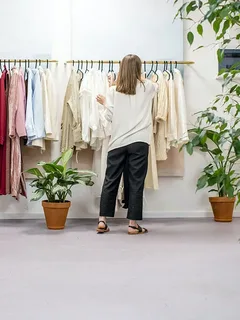Tips for Developing a Sustainable Wardrobe

In recent years, sustainability has moved from a buzzword to a lifestyle choice for many. With the fashion industry being one of the major contributors to environmental damage, more people are looking to build a wardrobe that’s both stylish and eco-friendly. Developing a sustainable wardrobe isn’t just good for the environment; it also encourages thoughtful consumption, reduces waste, and can even save you money in the long run.
This guide will walk you through practical tips on how to curate a wardrobe that reflects your personal style while making a positive impact on the planet.
Invest in Quality Over Quantity
One of the most effective ways to build a sustainable wardrobe is to invest in high-quality clothing. Rather than filling your closet with fast fashion pieces that may only last a few wears, prioritize items made from durable materials that will stand the test of time. Quality pieces often come with a higher price tag, but they are a long-term investment. These items tend to last longer, meaning you’ll replace them less frequently.
In the context of gift-giving, especially during festivals like Diwali, investing in quality clothing items as part of Diwali Gifts can also promote sustainability. Rather than opting for trendy, short-lived pieces, choose timeless designs that the recipient can enjoy for years.
Choose Natural and Sustainable Fabrics
The fabric of a garment plays a significant role in determining its environmental impact. Synthetic fabrics like polyester and nylon are made from petrochemicals, which are harmful to the environment and take hundreds of years to decompose. Instead, opt for natural fabrics such as organic cotton, linen, hemp, or bamboo. These materials are biodegradable and tend to have a lower carbon footprint. Additionally, they are often more breathable and comfortable to wear.
For those looking to give eco-friendly Diwali Gifts, choosing garments made from sustainable fabrics adds a meaningful touch to the celebration.
Buy Second-Hand or Vintage Clothing
One of the most sustainable ways to shop is to buy second-hand or vintage clothing. Thrifting and shopping at consignment stores give pre-loved clothing a second life, reducing the demand for new production and the waste that comes with it. Plus, vintage pieces can add a unique flair to your wardrobe that you won’t find in fast fashion stores.
Online platforms like Depop, Poshmark, and eBay make it easy to find second-hand clothing, allowing you to shop sustainably from the comfort of your home. Not only will you be reducing your environmental impact, but you may also score some one-of-a-kind pieces that set your style apart.
Embrace Minimalism
Minimalism doesn’t mean sacrificing your style or living with just a few pieces. It means being intentional about what you buy and wear. When developing a sustainable wardrobe, try to focus on items that are versatile and can be mixed and matched to create multiple outfits. A capsule wardrobe is a great approach, as it emphasizes owning fewer items that you can wear in different ways.
To get started, choose neutral tones and classic cuts for staple pieces, such as a well-fitted pair of jeans, a crisp white shirt, and a black blazer. These items can easily be dressed up or down, making them perfect for a variety of occasions.
Support Ethical and Sustainable Brands
When shopping for new clothing, do some research on the brands you’re buying from. Many companies now prioritize sustainability by using eco-friendly materials, reducing their carbon footprint, and paying their workers fair wages. Supporting these ethical brands encourages better practices in the fashion industry and contributes to a more sustainable future.
Look for certifications like Fair Trade, Global Organic Textile Standard (GOTS), and OEKO-TEX to ensure that the brand is committed to sustainability and ethical production. Some well-known sustainable brands include Patagonia, Everlane, and Reformation.
Care for Your Clothes Properly
Proper care can extend the lifespan of your clothing, reducing the need to replace items frequently. Washing your clothes less often, air-drying them, and using cold water can prevent wear and tear. Avoid dry cleaning when possible, as it often uses harmful chemicals. When storing clothes, ensure they are clean and properly folded or hung to avoid stretching or wrinkling.
By taking better care of your clothes, you not only reduce waste but also keep your wardrobe looking fresh for longer periods.
Learn Basic Repair Skills
Rather than throwing out items with small tears or loose buttons, consider learning basic repair skills. Sewing on a button or patching a hole can significantly extend the life of a garment. If you’re not confident in your abilities, many communities offer mending workshops, or you can find helpful tutorials online.
Learning to mend your clothing is a simple yet effective way to reduce waste and build a more sustainable wardrobe.
Shop Less, Shop Smarter
One of the simplest ways to reduce your environmental impact is to buy less. Before making a purchase, ask yourself if you truly need the item. Will it complement the other pieces in your wardrobe? Will you wear it more than once? By being more mindful of your purchases, you can avoid impulse buys and focus on building a wardrobe that you genuinely love and will wear for years to come.
Conclusion
Building a sustainable wardrobe is a rewarding process that can benefit both you and the environment. By investing in quality pieces, choosing eco-friendly fabrics, supporting ethical brands, and embracing minimalism, you can create a closet that reflects your style while reducing your environmental footprint. Whether for yourself or as thoughtful Diwali Gifts, incorporating sustainability into your clothing choices helps promote a more conscious and responsible approach to fashion.




